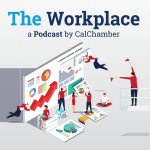In Episode 80 of The Workplace podcast, CalChamber Executive Vice President and General Counsel Erika Frank is joined by employment law experts Bianca Saad and Matthew Roberts to discuss what leave options are available to employees affected by school closures, and how employers should prepare for school closures during the incoming fall school term.
This podcast was recorded on July 20. Listeners should be aware that given the unpredictability of the COVID-19 crisis, the federal government may alter its relief programs at any time. Information presented in this podcast is accurate as of July 20, 2020.
California Governor Gavin Newsom has announced that most K–12 schools will not reopen in the traditional sense in the fall and students instead will be distance learning, Frank tells listeners.
The closure of schools and childcare centers greatly impacts working families, as many parents will not be able to work typical business hours in order to care for or provide instruction to their children.
Leaves Available
Prior to the COVID-19 pandemic, parents typically used leave under the California School Activities Leave law to cover child- and school-related emergencies and activities, Saad says.
The leave applies to businesses with 25 or more employees working at the same location, and provides 40 hours of unpaid leave a year. The law limits taking no more than eight hours of the leave a month, but that limit does not apply in emergencies, she explains.
Before federal options were put into place, this is the leave that most parents used when schools first began to close due to the pandemic, Saad tells Frank.
In response to COVID-19 closures, the federal government created two paid leave programs under the Families First Coronavirus Response Act (FFCRA): the Emergency Paid Sick Leave Act (EPSL) and Emergency Family and Medical Leave Expansion Act (EFMLA), Roberts explains.
The leave programs help employers with fewer than 500 employees keep their workforce on their payroll by providing a tax credit to reimburse any leave taken by employees, he says.
The EPSL provides up to 80 hours of paid leave at two-thirds the employee’s regular rate of pay when the leave is used for childcare-related reasons, while the EFMLA provides up to 10 weeks of paid leave at two-thirds the employee’s regular rate of pay.
The FFCRA was created at a time when most schools across the country were closing due to the pandemic, but there was no anticipation of the closures continuing in the fall, and employees who used the FFCRA in the spring are now in a sticky situation.
Under current law, if an employee has used up all of their FFCRA time during the spring school term, the employee will not be able to use the FFCRA in the fall because they’ve used up all of their allotment, Roberts says.
“[The EPSL] only provided for those two weeks; it didn’t provide two weeks for each occurrence of the school closure…so once those two weeks are up, they’re up,” he explains.
And the same goes for the EFMLA, he says.
Employers: Create a Workforce Plan
Due to the limitations of the FFCRA, Frank says, employers should expect to see a number of peculiar situations in the fall. Employers will have some employees who will have leave still available under the FFCRA and others who will have no more time left in their bank.
Employers should take this time to be creative and create a game plan for those employees who need time off due to school closures, but cannot access leave under the FFCRA, Saad says.
Frank suggests that employers assess their workforce now and determine which employees will be impacted by school closures and what types of working arrangements might work for them. For example, creating an alternate work schedule might be easier for exempt employees and trickier for nonexempt employees.
Some ideas suggested by Saad, Roberts and Frank, include offering:
• Unpaid leave;
• Alternate shifts or hours;
• The ability to work remotely; and/or
• A reduced schedule.
Employers should be sure to create a long-term plan, Roberts advises. He points out that if a county is placed on the Governor’s monitoring list, school closures would not only last for the duration that the county is put on the list, but for an additional 14 days after the county is removed from the list.
“…we are looking at a long-term planning situation, which is where that creativity and flexibility comes into place,” Roberts says.
Subscribe to The Workplace
Subscribe to The Workplace on iTunes, Google Play, Stitcher, PodBean and Tune In.
To listen or subscribe, visit www.calchamber.com/theworkplace.


